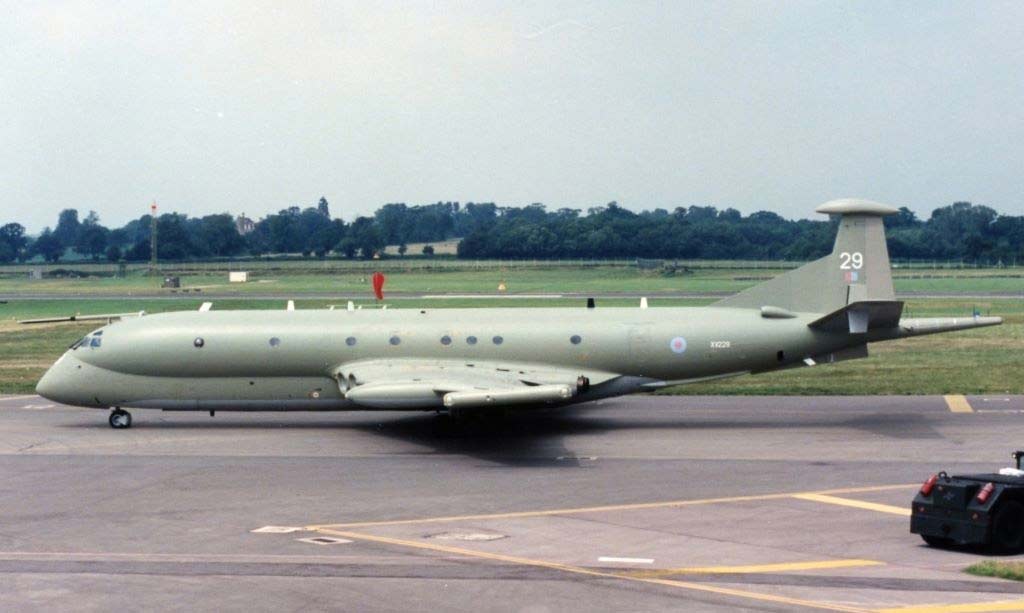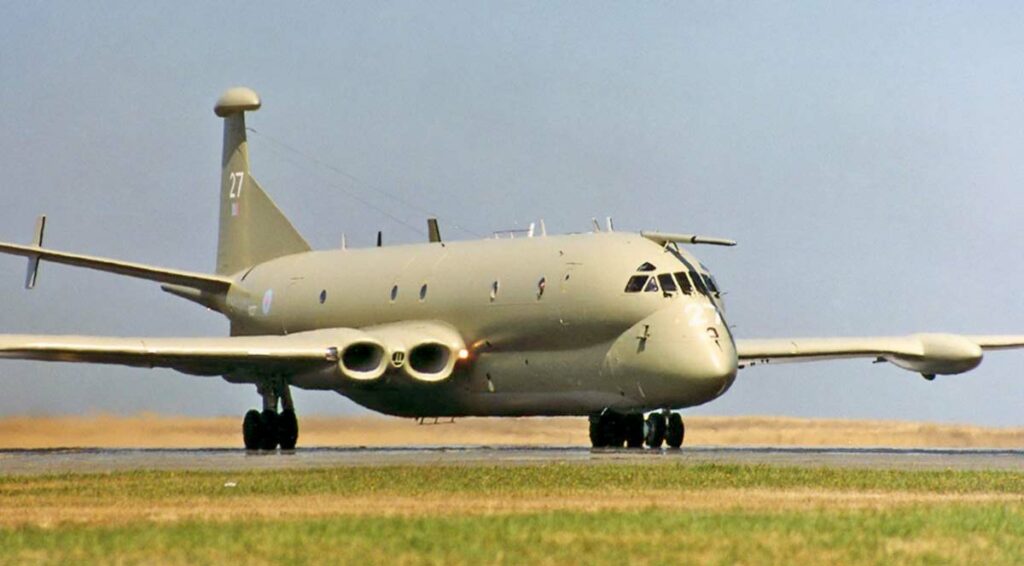The Nimrod was a British maritime patrol aircraft, excelling in anti-submarine warfare, surveillance, and reconnaissance roles.
In brief
The BAe/Hawker Siddeley Nimrod, derived from the de Havilland Comet, was Britain’s primary maritime patrol and anti-submarine warfare aircraft for decades. It featured advanced radar, magnetic anomaly detectors, and acoustic sensors, making it adept at submarine detection. Equipped with torpedoes, Harpoon anti-ship missiles, and depth charges, it combined significant payload capacity with long endurance, covering vast oceanic expanses for surveillance, search and rescue, and electronic intelligence gathering, solidifying its role as a versatile asset in maritime security.

History of the Development of the BAe/Hawker Siddeley Nimrod
The development of the Nimrod maritime patrol aircraft was a response to the increasing Soviet submarine threat during the Cold War era. The Royal Air Force (RAF) required a modern, sophisticated aircraft to replace the aging Avro Shackletons. The program, initiated by Hawker Siddeley, repurposed the de Havilland Comet, the world’s first jet-powered airliner, transforming it into a state-of-the-art maritime patrol platform.
The project, launched in the 1960s, aimed to create an aircraft capable of extended maritime surveillance, anti-submarine, and anti-surface warfare operations. The first flight of the Nimrod occurred on 23 May 1967. Its development was driven by the need for an aircraft with advanced sensors, extended range, endurance, and the capability to carry a significant arsenal of weapons. The “Nimrod,” named after a biblical hunter, reflects its intended role in seeking out and engaging submarine threats, although it was not assigned a specific NATO reporting name.
Design of the BAe/Hawker Siddeley Nimrod
The BAe/Hawker Siddeley Nimrod was innovatively designed, incorporating the existing airframe of the de Havilland Comet with significant modifications to fulfill its intended roles. The aircraft was equipped with state-of-the-art radar, sonobuoys, and magnetic anomaly detectors, essential for detecting submarines. Its internal weapons bay and underwing hardpoints allowed it to carry an array of armaments, including torpedoes, missiles, and mines.
The Nimrod featured a pressurized cabin, allowing for high-altitude flights, while its reinforced structure and upgraded systems enabled low-altitude operations essential for maritime patrol and search-and-rescue missions. The addition of a new wing, incorporating more efficient Rolls-Royce Spey engines, improved its range and endurance significantly. However, the complexity of integrating modern systems into the existing airframe presented challenges, including weight issues and maintenance demands.
Performance of the BAe/Hawker Siddeley Nimrod
The Nimrod’s performance was characterized by its long endurance and considerable range, essential for prolonged maritime patrol missions. Powered by four Rolls-Royce Spey turbofan engines, it was capable of speeds up to 500 knots, with a service ceiling of 42,000 feet and a range extending over 6,000 nautical miles, facilitating extensive surveillance operations.
Its capability to carry an extensive array of weaponry, coupled with advanced avionic systems, made the Nimrod a formidable platform for anti-submarine warfare and maritime reconnaissance. It was uniquely equipped to operate in both high-threat environments and peacetime surveillance, providing a versatile tool in the RAF’s arsenal, capable of adapting to the evolving technological landscape and mission requirements.
Variants of the BAe/Hawker Siddeley Nimrod
The Nimrod series saw various variants tailored to specific operational needs:
- Nimrod MR1/MR2: These were the primary maritime reconnaissance and anti-submarine warfare variants, with the MR2 undergoing significant avionics and systems upgrades to enhance its operational capabilities.
- Nimrod R1: A specialized variant configured for electronic intelligence gathering (ELINT), featuring an extensive array of sensors and communication equipment, but devoid of maritime patrol weaponry.
- Nimrod AEW3: An airborne early warning variant equipped with advanced radar and avionics, although it never reached operational service due to developmental challenges.
- Nimrod MRA4: A proposed upgrade of the MR2, featuring modernized avionics, improved engines, and an all-new wing, intended to extend the operational life of the fleet, but the project was eventually canceled.

Military Use and Combat of the BAe/Hawker Siddeley Nimrod
The Nimrod fleet served primarily in a peacetime role but was integral to NATO’s Cold War maritime strategy, tracking Soviet submarines and surface vessels. It participated in numerous NATO exercises, demonstrating its capabilities in anti-submarine warfare and maritime reconnaissance.
In conflict zones, the Nimrod was deployed for surveillance and intelligence-gathering missions, notably during the Falklands War, where it conducted crucial reconnaissance flights, gathering intelligence on Argentine ship movements and providing early warnings to the British fleet. Despite the long distances involved and challenging weather conditions, the Nimrod’s contributions were pivotal in maintaining operational awareness and safeguarding naval forces.
During the Gulf Wars and in operations over Afghanistan and Iraq, the Nimrod’s role expanded to include overland surveillance, signals intelligence, and coordination of coalition air operations. Its ability to gather intelligence and provide real-time data to ground forces made it an invaluable asset in modern asymmetric warfare environments, where situational awareness was crucial for mission success.
The aircraft’s armament capabilities, although primarily focused on anti-submarine warfare, included torpedoes, depth charges, and later, the capability to deploy precision-guided munitions. While not a combat aircraft in the traditional sense, its role in coordinating and directing air strikes, conducting electronic warfare, and providing battlefield surveillance underscored its versatility and adaptability to combat operations.
The Nimrod fleet also played significant roles in humanitarian missions, search and rescue operations, and disaster relief efforts, showcasing its adaptability beyond pure military applications. Its long endurance and comprehensive sensor suite made it ideal for coordinating large-scale search operations, locating vessels in distress, and directing rescue efforts.
Internationally, the Nimrod was operated exclusively by the United Kingdom’s Royal Air Force and didn’t see widespread export, partly due to its specialized nature and the specific strategic requirements it was designed to fulfill. Its operational service was marked by a continuous process of upgrades and enhancements, ensuring its relevance in the face of evolving threats and changing operational requirements.
The eventual retirement of the Nimrod fleet marked the end of an era for the RAF’s maritime patrol capabilities, with the aircraft being replaced by more modern platforms. The decision to retire the Nimrod was influenced by strategic reassessments, budgetary considerations, and the increasing maintenance challenges associated with aging aircraft. The cancellation of the MRA4 project left a capability gap that highlighted the unique role the Nimrod had played in Britain’s defense architecture.
The BAe/Hawker Siddeley Nimrod stands out as a cornerstone of British aerospace engineering, exemplifying a multifaceted approach to maritime patrol, anti-submarine warfare, and surveillance. Its development from the Comet airliner showcased innovative adaptations, transforming it into a sophisticated platform capable of a wide range of operations from intensive maritime patrol to critical roles in intelligence, surveillance, and reconnaissance (ISR) missions.
Back to the Special Aircraft section